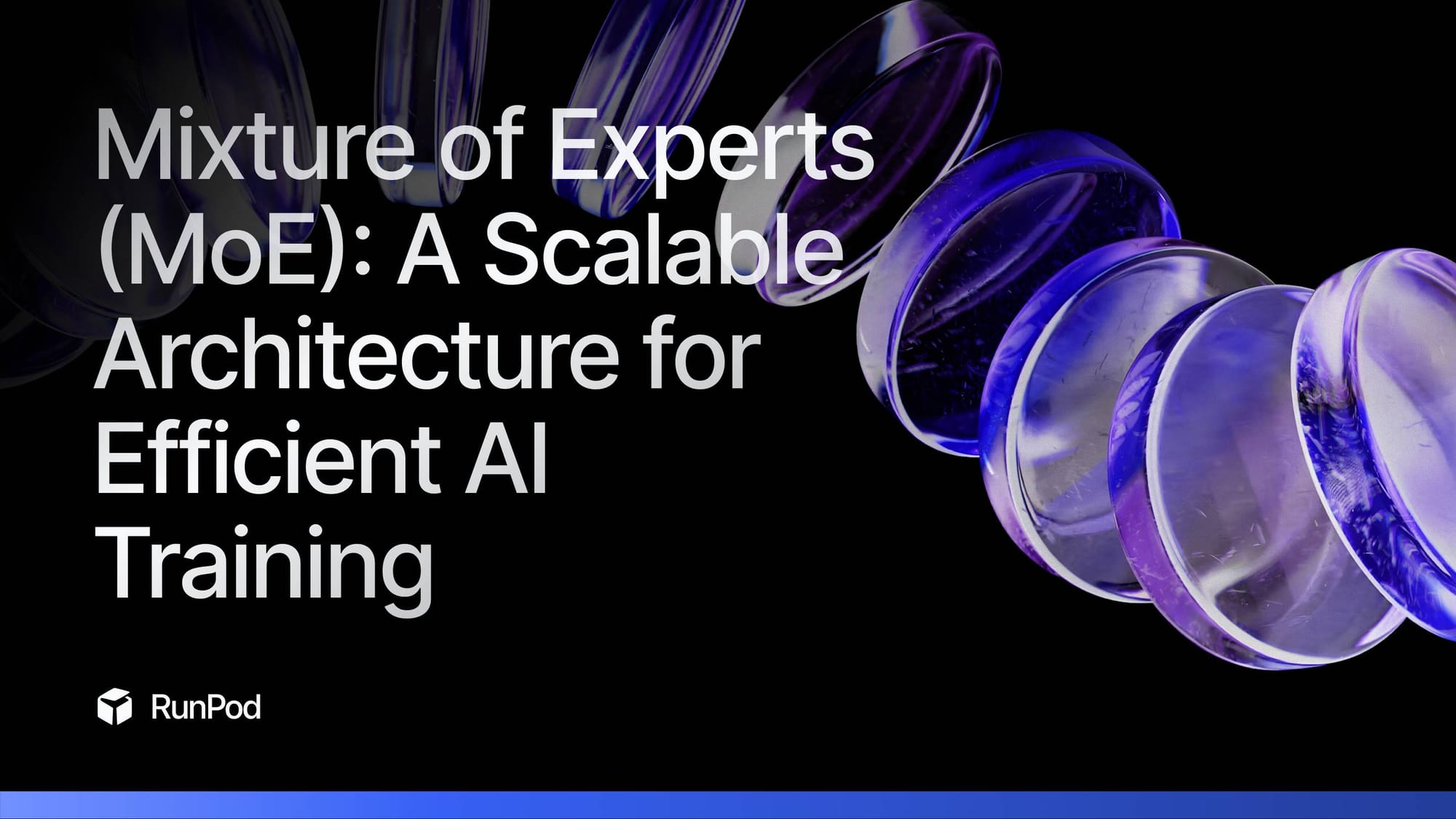Mixture of Experts (MoE): A Scalable Architecture for Efficient AI Training
Mixture of Experts (MoE) models scale efficiently by activating only a subset of parameters per input. Learn how MoE works, where it shines, and why RunPod is built to support MoE training and inference.

As large language models (LLMs) continue to balloon in size and complexity, brute-force scaling is showing its limits. Mixture of Experts (MoE) architecture offers a smarter way forward. Rather than lighting up every neuron like it’s a Vegas strip, MoE models take a more selective approach—activating only a few expert sub-networks per token. That small design shift unlocks massive gains in training speed, inference efficiency, and scalability.
Once a niche research curiosity, MoE has officially gone mainstream. OpenMoE, DeepSeek-MoE, and Mixtral are proving that you can scale to hundreds of billions of parameters without melting your data center.
What Is a Mixture of Experts?
A Mixture of Experts model is built from two key components: a gate network and a collection of expert sub-models. The gate acts like a bouncer—deciding which experts get to work on a given input—and only activates one or two at a time. Even if your full model has hundreds of billions of parameters, each forward pass only touches a small slice of them. That means you get massive model capacity with a more efficient use of compute during each forward pass—but there’s a catch. While MoE models activate fewer parameters per input, the full parameter set still needs to reside in memory. That means they often require just as much VRAM as their dense counterparts to load, even if they process more efficiently once running.
This kind of sparse activation is the magic sauce behind MoE’s appeal. It's not just about trimming GPU usage—it’s about making next-gen model scale practical for teams outside the hyperscaler club.
Why MoE Is Worth the Complexity
MoE models deliver several performance and architecture advantages:
- Compute efficiency: You're not spinning up the full model for every request—just the parts that matter.
- Parameter specialization: Experts can specialize in specific domains—like code, science, or Shakespearean insults—without bloating a single network.
- Scalability: You can grow your model capacity by adding more experts, without scaling compute linearly.
- Faster iteration cycles: Only parts of the model update per input, making training more modular and less resource-intensive.
That efficiency helps make trillion-parameter models feasible without trillion-dollar compute budgets. MoE is how teams are building bigger brains without burning bigger stacks.
Google (Switch Transformer), DeepMind (GShard), Mistral (Mixtral 8x7B), and DeepSeek V3 (671B) have already shown what’s possible. And thanks to open source, you don’t need a research lab (or a few dozen PhDs) to follow in their footsteps.
The Challenges You’ll Face
MoE isn’t magic—it’s more like a choose-your-own-adventure with some engineering booby traps. Routing and gating take careful tuning to avoid overloading the same experts. Training stability can wobble if your gate network lags behind. And even though you're using less compute per token, your overall memory footprint can still balloon.
These are solvable problems. But they do mean MoE is better suited to infrastructure that can handle a little complexity.
Why RunPod Is Built for MoE
RunPod was practically made for this. We support multi-node GPU clusters with high-speed interconnects—perfect for expert-parallel workloads. Our high-VRAM GPUs (A100s and H100s) give you the space you need for massive expert layers. And if you're deep into custom CUDA ops or routing tricks, our bare metal access lets you get as close to the hardware as you like.
Best of all? MoE models are designed to be efficient—and RunPod’s pay-as-you-go pricing model rewards that kind of architectural restraint. Whether you're experimenting or scaling, your budget will thank you. And if you’re deploying MoE models via RunPod Serverless, you’ll actually see real cost and speed advantages—the faster inference times mean lower per-request pricing and snappier response times for end users.
Tools to Support MoE Training and Deployment
Several frameworks now support Mixture of Experts out of the box:
- DeepSpeed provides expert parallelism with ZeRO integration, making it ideal for large-scale MoE training.
- Colossal-AI offers a lightweight MoE-ready training stack built for distributed efficiency.
- Hugging Face Transformers includes community-built MoE models like Mixtral that can be easily fine-tuned.
- PyTorch FSDP has added support for sharded MoE models to optimize memory and speed.
You can spin any of these up on a RunPod cluster in minutes. No special incantations required.
Start Experimenting with MoE
If you're MoE-curious (and really, who isn't?), there's no need to start big. A pair of A100 80GB pods is enough to prototype small-scale expert models. From there, you can scale up to multi-node H100 clusters, persist your datasets using RunPod Volumes, and fine-tune your routing logic as you go. If you want total control over performance, bare metal gives you the keys to the kingdom.
As AI continues to scale, architecture matters as much as raw size. Mixture of Experts is one of the most promising paths toward smarter, more efficient models—and RunPod is here to help you build them.
Ready to explore MoE in your own pipeline? Spin up a MoE-capable pod and start training today.
